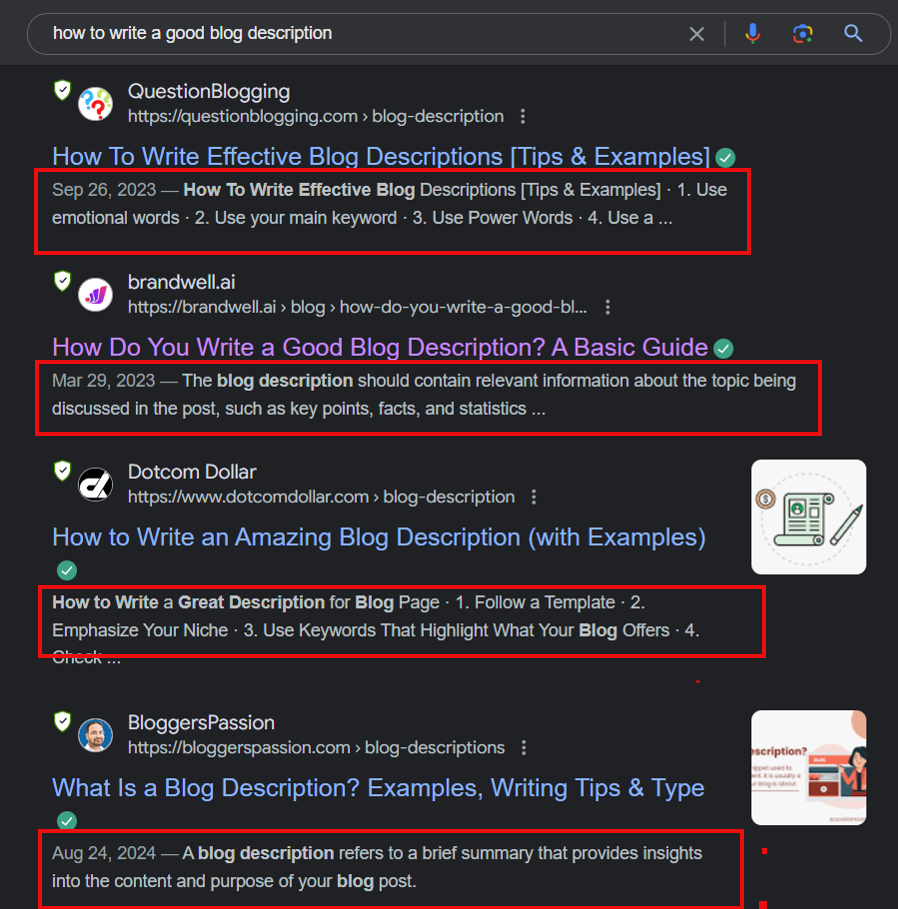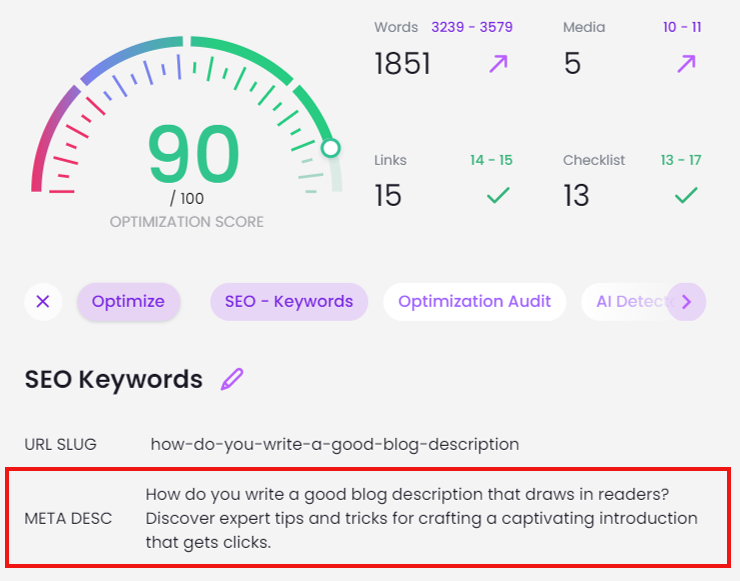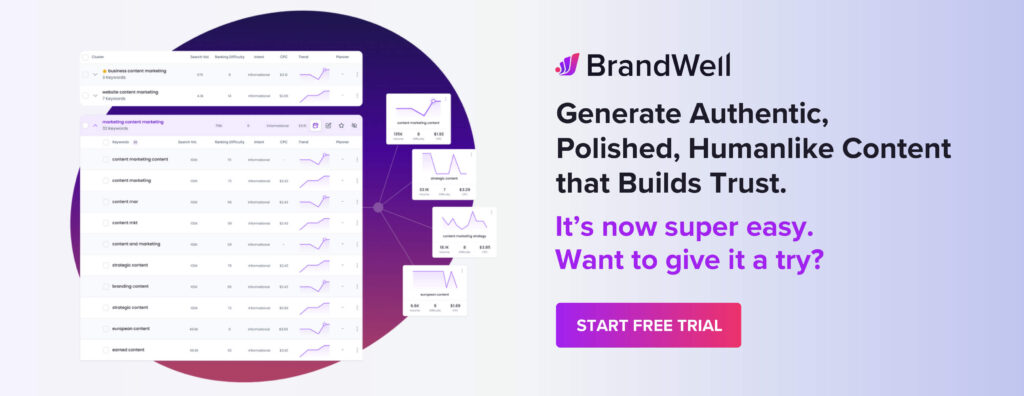Discover top guides, trends, tips and expertise from AIO Writers
How Do You Write a Good Blog Description? A Basic Guide
Julia McCoy
Wednesday, 29th Mar 2023
How do you write a good blog description? And why does it matter?
When people see your blog post title on search engine results pages (SERPs), they will also see a short snippet that describes what your page is about. Blog post descriptions can influence organic click-through rates (CTR), which is why it’s important to learn how to write a good blog description that will entice more clicks — and more traffic.
According to a study conducted by Ignite Visibility, meta descriptions have the biggest influence on whether visitors click on a search result (63%), followed by brand name (24%) and page title (13%). This is probably because meta descriptions contain 160 characters rather than just 65 in a page title.
So, do you know how to write a good blog description?
If not, don’t worry. We’ll teach you how to write blog post descriptions that are catchy and compelling so you’ll soon have readers hooked to your content.
Table of Contents
What is a Blog Description?
A blog description is a brief introduction to the content and purpose of your blog post that appears below the blue link of a search result. Any words that match the search term are bolded in the blog description.
Blog post descriptions are often the make-or-break moment for your blog — either the visitor will click on your listing or scroll away. Therefore, a good blog post description should be relevant, engaging, and straightforward.
Here are a few blog description examples that would show up on a search engine results (SERP) page.

Blog descriptions present an opportunity to convince and persuade the searcher to click through to your website. They are the first thing that visitors see when they type something on Google, and they can be the difference between clicking on your listing or moving on to the next SERP entry.
A higher CTR (click-through rate) means more people are clicking on your link when it appears in the SERP, which can lead to increased traffic to your website. Therefore, it is essential to learn how to write blog descriptions that will attract readers and increase engagement.
Why Should You Write a Custom Blog Description?
Specialized content creation tools like BrandWell’s RankWell can automatically write a blog description for you. Each blog post it generates comes with an SEO-optimized meta description that fits the topic of the piece.

But because this is still a bot, chances are some of the blog descriptions it will generate may sound generic. This is why it’s important to always go through each description and give it a human touch.
A custom blog description provides search engines with more information about the page’s contents. It also helps increase click-through rates from organic searches by providing readers with an accurate summary of what they will find on the page. This is especially important for websites that are trying to compete in competitive industries or markets where many similar pages are vying for attention from potential customers.
By having a custom blog description that stands out from other results on SERPs, you have a better chance of grabbing someone’s attention and enticing them to click your link instead of another one.
Key Elements of a Blog Description
The answer to “How do you write a good blog description?” includes knowing the key elements to include every time.
Relevant Information
The blog description should contain relevant information about the topic being discussed in the post, such as key points, facts, and statistics that can help readers understand what the post is about. This will make it easier for them to decide whether or not they want to read more of the content.
Including a brief summary of what’s included in the blog post can also be helpful for readers who are looking for specific topics or answers quickly.
Keywords should also be mentioned in the description to ensure that search engines can easily find and index your content correctly.
Catchy Intro
A catchy intro is essential when it comes to writing a good blog description because it helps draw people’s attention and encourages them to click on your post link instead of another one with similar keywords but less interesting titles. It should be creative enough to stand out among other search results and get more clicks and engagement from potential customers.
How Do You Write a Good Blog Description?
A good blog post description will draw in new readers while also giving search engines something to index.
Crafting an effective blog description requires careful consideration of your target audience, keywords, and tone to draw attention and encourage clicks.
When you write blog post descriptions, it’s important to keep them short and sweet, use keywords strategically, include a call-to-action, and optimize them for search engines.
Keep It Short and Sweet
How do you write a good blog description?
When it comes to writing a meta description for blog posts, brevity is key. It should be concise and straightforward, without any fluff or filler. The meta description should provide readers with an overview of the post’s content, and include keywords to help search engines find it.
The perfect blog description is no longer than two sentences. You don’t want to overwhelm your readers with too much information before they even click on the link to read the full post.
Make sure each sentence conveys something useful about what’s inside so readers know exactly what they’re getting when they click through. This will increase engagement rates which will ultimately result in increased website traffic.
Focus on your title tag and meta-description to get more attention and more clicks. More clicks = better ranking. #seo #tips
— SEO Quotient (@SEOQuotient) December 2, 2016
Use Keywords Strategically
Using keywords strategically in your blog description is an essential part of SEO. Keywords are the words that people use to search for information on a given topic, so it’s important to make sure they appear in your blog description if you want your post to be found. The right keywords can help draw more traffic to your website, increasing engagement and improving visibility.
When selecting keywords for your blog description, think about what terms someone might type into a search engine when looking for information related to the topic of your post.
If you’re writing about how to create an effective email campaign, then some relevant keywords might include “email marketing strategy” or “best practices for email campaigns”.
Make sure these terms appear somewhere in the text of your blog description so that readers know exactly what they will find when clicking through from a SERP.
Placing key phrases at the start of sentences or clauses can be beneficial when it comes to writing a good blog post description. Rephrasing your text in this way will not only improve readability but also ensure that Google bots pick up on relevant keywords more easily during the indexing process. With a well-crafted blog description featuring strategically placed keywords, you can draw more traffic to your website.
Choosing keywords strategically before starting on a project can be likened to setting up the pieces of a board game – it provides multiple paths leading back to the main objective, regardless of how winding their journey may become. With targeted words throughout the copy, SEO efforts are more likely to bear fruit as readers discover content relevant to their search queries — even if they weren’t looking for that particular topic initially.
Lastly, active voice usage, proper grammar, and punctuation as well as avoiding exclamation points all contribute to a powerful blog post description.
Include a Call-to-Action
How do you write a good blog description that entices people to click your link?
Add a call-to-action at the end of every blog description to encourage readers to take action. You want them engaged enough with your content so that they actually do something afterward.
Including calls-to-action in your blog description helps direct readers to subscribe to newsletters, download ebooks, and any other action related to the topic discussed in the post.
By adding CTAs to your blog descriptions, you are able to increase engagement by prompting users into completing certain tasks which can ultimately lead them down a sales funnel.
When writing effective calls-to-action, use clear language that conveys what type of action you want your visitors to take. Avoid using jargon and technical terms as these may confuse potential customers.
You should also use active verbs when creating CTAs such as “download now” instead of “click here” so that readers know exactly what they need to do.
Optimize for Search Engines
Optimizing meta descriptions can help you increase the click-through rate from organic search results and drive more traffic to your website.
For optimal search engine visibility, strategically place keywords throughout the description in prominent locations such as the start of sentences.
In addition to using relevant keywords, write compelling copy that encourages readers to click through and learn more about what you have written in your blog post. You want them intrigued enough so they feel compelled to visit your blog without giving away too much information.
Think of it like a mini elevator pitch – if someone were asking you “What’s this article all about?”, how would you answer them?
When done correctly, these small tweaks can make a big difference when a visitor has to decide between clicking your link or moving to the next search result. Why not give yourself an edge over competitors by writing great blog post description examples?
Common Mistakes to Avoid When Writing Blog Descriptions
One common mistake people make when creating their own descriptions is using generic phrases such as “click here” or “read more” which don’t really tell people what type of content awaits.
Another mistake is including too much detail in the meta description which defeats its purpose. The main goal of a blog description is to make people curious enough without giving away all the secrets right away.
Finally, avoid stuffing too many keywords into one sentence. Try spreading them out naturally throughout each description for maximum effectiveness.
Conclusion
When you write effective blog descriptions, they can help attract readers to your blog post and increase click-through rates.
How do you write a good blog description? Make sure that your descriptions are short and sweet but still include keywords strategically, a call-to-action, and optimization for search engines. With these tips in mind plus some great examples as inspiration, you’ll be well on your way to writing effective blog descriptions.

UNLOCK YOUR POTENTIAL
Long Headline that highlights Value Proposition of Lead Magnet
Grab a front row seat to our video masterclasses, interviews, case studies, tutorials, and guides.



